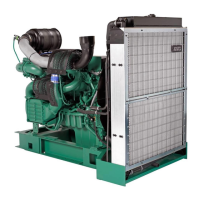Do you have a question about the Volvo Penta TWD1672GE and is the answer not in the manual?
Essential PPE like gloves, goggles, and protective clothing for safe operation and maintenance.
Covers hazards of rotating parts, hot surfaces, ventilation, starting, and fire prevention.
Safety procedures for electrical, cooling, fuel systems, and battery handling.
Explains the manual's content, warranty terms, and owner responsibilities.
Covers engine running-in, fuel/oil/coolant recommendations, and parts.
Details on environmental care, certified engines, EATS, and emergency override.
Details on TWD1672GE/TWD1673GE engines, EMS, and EATS systems.
Covers EATS shut-down, overview, tank management, heating, storage, and operation.
Description of the DCU II panel, its menus, status bar, and alarm system.
Details on CIM panel, settings, and Easy Link instruments.
Importance of visual checks of the engine and engine room before starting.
Step-by-step guide for starting the engine using the ignition and start buttons.
Procedure and safety precautions for starting the engine using auxiliary batteries.
Checking instruments and understanding engine alarms for safe operation.
Techniques for maneuvering and avoiding prolonged operation at low load.
Steps for warming up, stopping the engine, and auxiliary stop functions.
Checks and actions required after the engine has been shut down.
Overview of diagnostic function, CIM/DCU II and Easy Link fault reporting.
Common symptoms, causes, fault code register, and EATS warnings/inducements.
Procedures for checking EATS quality shortcomings and component defects.
Details on service intervals (S1, S2, S3, Type A, B, C) and extended intervals.
General inspection, air filter, charge air pipe, drive belts, and alternator belts.
Procedures for lubrication, fuel, and cooling systems, including filter changes.
AdBlue®/DEF filling, pump filter change, and electrical system safety.
Battery maintenance, replacement, and engine storage procedures.
Specifications for engines, lubrication system volumes, pressure, and oil.
Details on fuel, cooling system, water quality, electrical system, and batteries.
Location and meaning of engine identification numbers and labels.
Essential PPE like gloves, goggles, and protective clothing for safe operation and maintenance.
Covers hazards of rotating parts, hot surfaces, ventilation, starting, and fire prevention.
Safety procedures for electrical, cooling, fuel systems, and battery handling.
Explains the manual's content, warranty terms, and owner responsibilities.
Covers engine running-in, fuel/oil/coolant recommendations, and parts.
Details on environmental care, certified engines, EATS, and emergency override.
Details on TWD1672GE/TWD1673GE engines, EMS, and EATS systems.
Covers EATS shut-down, overview, tank management, heating, storage, and operation.
Description of the DCU II panel, its menus, status bar, and alarm system.
Details on CIM panel, settings, and Easy Link instruments.
Importance of visual checks of the engine and engine room before starting.
Step-by-step guide for starting the engine using the ignition and start buttons.
Procedure and safety precautions for starting the engine using auxiliary batteries.
Checking instruments and understanding engine alarms for safe operation.
Techniques for maneuvering and avoiding prolonged operation at low load.
Steps for warming up, stopping the engine, and auxiliary stop functions.
Checks and actions required after the engine has been shut down.
Overview of diagnostic function, CIM/DCU II and Easy Link fault reporting.
Common symptoms, causes, fault code register, and EATS warnings/inducements.
Procedures for checking EATS quality shortcomings and component defects.
Details on service intervals (S1, S2, S3, Type A, B, C) and extended intervals.
General inspection, air filter, charge air pipe, drive belts, and alternator belts.
Procedures for lubrication, fuel, and cooling systems, including filter changes.
AdBlue®/DEF filling, pump filter change, and electrical system safety.
Battery maintenance, replacement, and engine storage procedures.
Specifications for engines, lubrication system volumes, pressure, and oil.
Details on fuel, cooling system, water quality, electrical system, and batteries.
Location and meaning of engine identification numbers and labels.
| Engine Model | TWD1672GE |
|---|---|
| Manufacturer | Volvo Penta |
| Engine Type | Diesel |
| Number of Cylinders | 6 |
| Compression Ratio | 17.5:1 |
| Cooling System | Liquid-cooled |
| Fuel System | Common Rail |
| Aspiration | Turbocharged |
| Power Output | 565 kW |
| Emissions Compliance | EU Stage IIIA |
| Rated Power | 565 kW (768 hp) |











